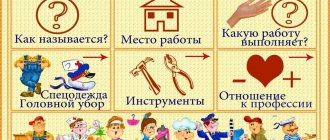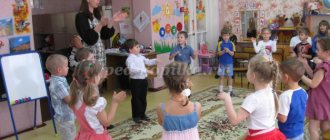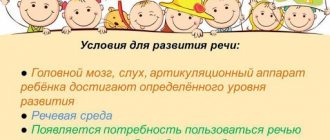On the topic: methodological developments, presentations and notes
Objectives of the lesson: - to clarify children’s knowledge about grain growers, bread and its path to our table; - to continue enriching the vocabulary, the formation of grammatical structure, the development of coherent speech; - to cultivate a caring attitude.
I bring to your attention a summary of a lesson I conducted in a senior speech therapy group.
Summary of a subgroup speech therapy lesson in the senior group. Lexical topic: “Autumn. Trees.".
Summary of a subgroup speech therapy lesson in the senior group. Lexical topic: “Autumn. Trees.".
Summary of a subgroup speech therapy lesson in the senior group Lexical topic “New Year”. Sounds k, k. Automation of sound w. Correctional and educational goals. Consolidation.
Consolidating the correct pronunciation and distinction of sounds [р] [р'] in words.
Summary of a subgroup speech therapy lesson in the senior group on the topic: “Winter. New Year holiday".
Progress of the lesson
Introduction
The teacher asks the children to take their seats. Cheerful music is playing. The teacher says: “It seems that an unusual guest came to us today. Please look what he left in the locker room (takes out a frying pan)! Who do you think came to see us today?” Children offer their options (cook, Maslenitsa, Kolobok).
The teacher shows them an illustration for Marshak’s poem “He’s so absent-minded” and reads the poem. Then she asks: “What did the frying pan turn out to be for the Absent-Minded One? That's right, a headdress. Of course, he put it on his head instead of a hat by mistake. Let’s correct his mistake and remember everything that can be put on your head in different seasons.”
Game "On my head"
Children pass the ball to each other and name the hats, saying: “On my head...”. Everyone answers in turn. The winner is the one who remembers the required name last.
The topic of hats has already been encountered in the course program on speech development in the senior group, so this lesson reinforces the material.
Game "Guess what's on my head"
The teacher says: “You remembered and named many different hats, and now we will try to guess the one that each of you sees in the picture.” Then she lays out subject cards with hats in front of her, calls each child, asks them to choose one of the illustrations, but not name it. The child is asked to tell about the hidden object. Other children must guess the wardrobe item in question.
Articulation gymnastics
The teacher invites the children to rest a little on their own, but do gymnastics for the tongue according to the fairy tale “At Grandma and Grandpa’s.”
Conversation on the painting “Where does the shirt come from”
The teacher shows the picture, the children look at the illustration.
Then the teacher asks: “Tell me, what professions do people make clothes?” Children list their specialties: weaver, seamstress, fashion designer, cutter. The teacher clarifies about each of them:
- What is this employee doing?
- Why is he doing this?
- Where is his workplace?
- What tools help him work?
“Why are there people in the picture collecting something in a field? Do clothes grow in the field? Children answer, the teacher complements the story about cotton (with a demonstration of a cotton boll, as well as cotton fabric).
Making a story with pictures
The teacher takes one picture from the series for a speech therapy lesson on the topic Clothing. Then he discusses with the group what is drawn on it. Children complete the story. All pictures are laid out in order. Then they are mixed and the teacher invites someone to arrange them again, repeating the story in full.
Game “Sew clothes for a bear”
Everyone sits in a circle. The teacher invites everyone to pass a piece of cotton fabric to each other, naming the clothes that could be sewn from it for a teddy bear.
Learning and repeating tongue twisters
The teacher asks you to remember tongue twisters about clothes. Offers several for memorization. For example:
Cuckoo bought a hood. The cuckoo put on his hood - How funny he is in the hood!
Fizminutka
It is held at the table.
- They collected the cotton together (we actively move our hands, “collecting” the boxes)
- We wove fabric from it (we move it back and forth with both hands, simulating the operation of a loom)
- They cut it out. (“cut” with scissors)
- We will sew, (“we scribble” on a typewriter)
- So that everyone can wear new clothes! (hands on waist, slightly turn to the sides)
For any speech therapy lesson in the senior and preparatory groups, it makes sense to select poems that are appropriate in meaning for the physical education break.
Getting to know the mnemonic table
Educator: “Now you and I will play riddles. Here is a hint table that will help us. Let's take a close look at the small drawings that are on it. If I want to talk about this winter hat, then the table will not let me forget anything!”
The teacher writes a short description about the winter hat, based on pictograms. (This is put on the head, this is a headdress - Everyone wears it - We wear such a headdress in the cold season - It is knitted from wool, it is warm - This thing is multi-colored, with stripes). Then the teacher offers to play with the pictures and table.
Game “Describe and Guess”
The teacher lays out pictures with images of clothing items. Children (one by one) approach the table, each of them opens one picture, describes the image, but does not name it. The rest guess what the presenter saw.
Game "Clothes for work"
The teacher tells the group that people of different professions dress in a special way at work. Then she asks everyone to divide into subgroups, gives each of them one card depicting the attributes of the profession, as well as a complete set of pictures of different items of clothing. Each group selects the necessary cards from the set. At the end of the game, the teacher shows everyone the selected items of clothing for each specialty, everyone discusses the correct selection of cards.
A moment of poetry
Educator: “We talked about the clothes that people wear at work. What kind of clothing does someone who stands outside all day in winter need? What if it’s not a person, but a snow woman? Does she need to be dressed? The children answer, and then the teacher reads S. Cherny’s poem “The Snow Woman” and asks them to answer the questions:
- Why did the boy decide to take out clothes for the snow woman?
- What did he choose for her?
- How did he dress himself to go out?
- What will happen in the morning?
- What would you say to a boy if you were the snow woman?
Game "Let's go for a walk"
The whole group sits in a circle. Children pass the ball to each other, naming items of winter clothing, winter shoes, and hats.
The lesson ends. The teacher thanks everyone for their answers, once again reminds them of the topic of the last lesson, and offers an assignment for home (draw yourself or someone else in your favorite clothes).
This lesson summary may be useful for speech therapists, as well as teachers involved in the development of speech of children in the senior group of kindergarten. Some of the exercises may be useful for parents whose children attend a speech therapy group.




